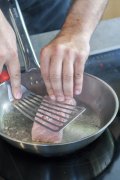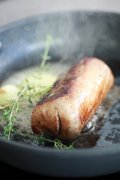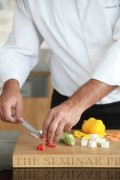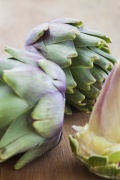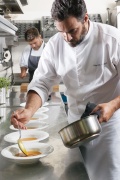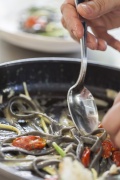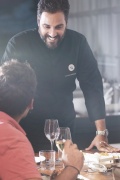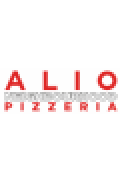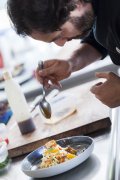 TIPS
TIPS
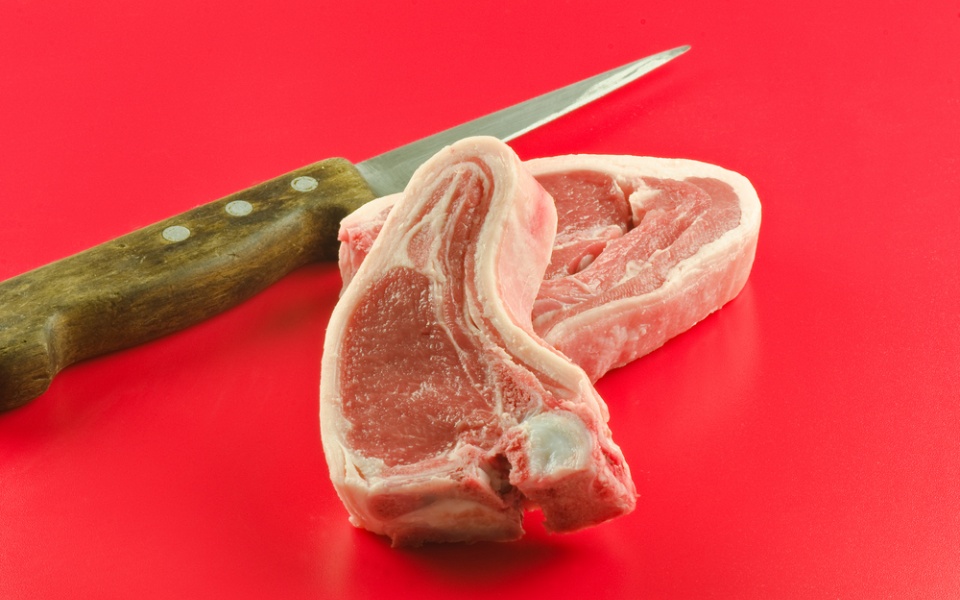
A very important aspect of cooking is food safety and hygiene.
Basic rules for food hygiene which will help protect your health from germs include:
• Cleanliness
The cooking area must be clean and disinfected not only at the start of cooking but also during cooking; this means you must tidy up and throw away anything you no longer wish to use, clean and continue. Of course, you mustn’t forget to clean up after you have finished cooking.
• Cutting surface: cleaning and use
Cutting surfaces are among the most basic sources of contamination in the kitchen. It is best to use plastic cutting surfaces since they collect fewer microorganisms than wooden boards. Cutting surfaces must be washed during cooking and especially before or after the preparation of meat or fish. If, for example, you chop vegetables and then want to cut meat, you must wash and disinfect the cutting surface, cut the meat and then repeat the cleaning process before embarking on the next task. A general rule is that you must never embark on a task on another task’s remains. In professional kitchens there are different cutting surfaces differentiated by color. The color of each cutting surface is used for a different category of foods, reducing thus the possibility of one food contaminating another. This is an excellent practice which can also be used on a daily basis at home. What I recommend is that you have 3 cutting surfaces (in professional kitchens there are at least 7), one for raw meat and fish, one for vegetables and one for food which is ready to be consumed. It doesn’t matter which color is which, as long as your remember which category every color corresponds to.
• Do not mix different types of food
You mustn’t mix various types of food or allow them to come into contact because this encourages the transfer of germs from one to the other. This is a general rule which also applies during refrigeration and preparation. Never mix raw and cooked or ready for consumption foods. Never place a raw chicken fillet next to a washed salad. Similarly, do not mix different category foods, such as fruit and meat. Moreover, never forget that food stored in the fridge must always be covered.
• Beware of raw foods
Raw eggs are likely to contain salmonella, a dangerous bacterium. For this reason, their consumption should be avoided. What does this mean? It means that eggs must be heated to 75°C before consumption so as to be pasteurized. If, therefore, a recipe suggests the use of an egg which will not be cooked at this temperature, it should be avoided. Such recipes include mayonnaise, various custards and French meringue. The solution is to use pasteurized eggs or heat the eggs in a bain-marie at the right temperature.
• The correct fridge and freezer temperature
The fridge’s interior temperature must be between 2 and 5°C. A very good tactic is to check the fridge’s temperature regularly. Remember that, the more we load the fridge, the less efficient the cooling. Never place hot food in the fridge or freezer. The food’s high temperature will increase the fridge’s temperature, creating conditions which may affect other foods in the fridge. The freezer offers the possibility of preserving food for relatively long periods. It should be noted, at this stage, that although freezing does not allow bacteria and microorganisms to breed, it does not destroy them. We must always select fresh and good quality foods for freezing and always follow basic hygiene rules while cooking. Correct freezing is achieved at temperatures below -18°C. Such temperatures do not, usually, correspond to the freezers commonly found in domestic settings. If we do not have a freezer which we can regulate to the ideal temperature, it is best not to assume that we can store frozen foods for long periods of time.
• Correct storage and appropriate cooking for ‘sensitive’ foods
Sensitive foods such as meat, fish, eggs, dairy products, cheeses, cured meats and cooked foods must be kept at fridge temperatures. When you have to work with sensitive foods, you must ensure they do not stay out of the fridge any longer than absolutely necessary. If, for example, you want to prepare a recipe using beef, you mustn’t take it out of the fridge for longer than a few minutes before using it. Another important factor for sensitive foods is the degree of cooking; the temperature, in other words, that the inside of the food must have at the end of the cooking process. The degree of cooking for most meat or fish is subjective and depends on personal taste. From a hygiene point of view, however, things are more absolute. There are, thus, specific (internal) temperatures at which each food is safe to consume. Most sensitive foods must have an internal temperature of 70 to 75°C at the end of their cooking time.
• Life expectancy of cooked foods
The official rule is that most cooked foods have a life expectancy of 72 hours from the moment they were cooked. Some foods last longer and this can be ascertained experientially. 3 days are however a good ‘alarm bell’ to use as your guide.
• Correct thawing
Correct thawing is a very important process; if it is not performed correctly there is the danger of hazardous microorganisms developing in the food. The ideal way, which offers absolute safety during thawing, is to place the food in the fridge and allow it thaw completely. This is time-consuming and requires planning. Another good and safe method is to place the packaged food under running water until thawed. In this case you must, of course, ensure that the packaging is waterproof so that the food doesn’t come into direct contact with the water. You must also make sure that we do not allow long after thawing has been achieved. If performed correctly, the above methods allow you to store the food for 3 days in the fridge after thawing. If you use a microwave for defrosting, it is best to cook the food immediately.
Attention! Food which has been thawed must never be frozen as second time in the same state.

